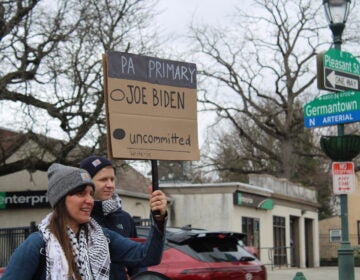Philadelphia architect Robert Venturi retires at age 87
Philadelphia-born architect Robert Venturi announced his retirement this week. He is regarded as one of the most influential architects of the 20th century and was awarded the Pritzker Architecture Prize in 1991.
His work includes the Christopher Columbus Monument at Penn’s Landing, Franklin Court on Market Street, which serves as a gateway to exhibitions about Benjamin Franklin, as well as the Guild House, an historic apartment building located on Spring Garden Street.
These Philadelphia landmarks were created by Venturi through his firm, Venturi, Scott Brown and Associates, which he co-owned with his wife and fellow-architect, Denise Scott Brown.
With the couple’s succession from the company, the firm has adopted a new name, VSBA, LLC, and is now overseen by Dan McCoubrey and Nancy Rogo Trainer. The group is still headquartered at 4236 Main Street in Manayunk, where it has held an office since the 1960s.
McCoubrey, who has been with the firm for 30 years, recently oversaw the Curtis Institute of Music’s new Lenfest Hall and renovations at the Allentown Art Museum. He says the firm will build on architectural and planning principles instituted by its founders.
“[Venturi and Scott Brown] started the succession a few years ago and have grown out of it very naturally,” explained McCoubrey.
He says the last project that Venturi worked on was in 2008 for the Episcopal Academy Chapel, which is part of a school in Newtown Square, Pa.
He described the office dynamic as democratic, intellectual, playful and daring.
“They would always consider the ethical dimension to design,” said McCoubrey of the duo, “they really looked at social issues.”
A rebel love story
When asked what drew the power-couple together, Denise Scott Brown explains, “we were both rebels” who had a different perspective than many of their colleagues.
The two met in the late 1960s on the University of Pennsylvania campus where they were both teaching. Denise recalled a proposal to demolish the school’s Fisher Fine Arts Library, which compelled her to protest.
“I told them that I thought the notion to demolish that building was a huge mistake,” recalled Scott Brown, “and after I was done speaking, Robert came up to me and told me he agreed with everything I said. He was the only one who agreed with me.”
The library was not demolished and the two were reunited with the building in 1991 when the firm was asked to implement a complete renovation there.
She says one of her favorite moments in architecture was learning that people brought in bicycles and were able to cycle through a space the group created.
“With all of our work, there’s nothing better than seeing people using it,” said Scott Brown. “It’s like producing a jungle gym for grown-ups. We build it so that they can explore it, go wherever they want. Spaces can be used in many ways.”
Controversy-turned-history
Part of the duo’s impact on the architectural community includes what was once considered a controversial book, “Learning from Las Vegas.”
Jeremy Tenenbaum, director of marketing and graphics at the firm, says the book is now a part of architectural history.
“It was a controversial theory,” explained Tenenbaum, “flashy neon signs wasn’t respectable architecture. Many people say to do more of ‘x’ and less of ‘y.’ They said that both ‘x’ and ‘y’ are good. And their work has become a part of our world now.”
Scott Brown says that at the time, having a controversial reputation meant losing potential clients.
“Our generation of architects found it vulgar and impossible,” she said, “but we thought we saw something there, some sort of truth in Las Vegas.”
In the book, she says they wrote about sustainability long before it became a popular idea.
“Now, they understand that the book was a social as well as an aesthetic document,” said Scott Brown, who hopes that new architects will also dare to be different.
“We tell them to work with a purpose and to have fun,” she said, “to do it your way and think about new social issues.”
Living legacies
McCoubrey says one of his favorite projects was Franklin Court.
“It was a re-imagined interpretive design,” he said. “I think it was a completely fresh idea – that grew out of a pragmatic approach to interpreting history.”
Another infamous building of the firm is the Vanna Venturi House in Chestnut Hill, which Venturi built in 1964.
“He built the house for his mother,” said Scott Brown, “we even lived in an upstairs part of the house when we were just starting out as a young married couple.”
The couple still visits their Manayunk office and Scott Brown is freelance writing for various architectural publications, including some in Italy, as she is affluent in the language. She is also working with an architect from Peru on building a village.
“I’ve wanted to write since the 1960s and now I can do it with a better perspective. I’m working on deadlines as if I was 25-years-old and I’m 80,” she said with a laugh.
Scott Brown says the couple’s main focus is to enjoy life in their West Mt. Airy home, which is an Art Nouveau style mansion. They frequent a local coffee shop and spend time with their new English Springer Spaniel puppy, Aalto, lovingly named after Alvar Aalto, a favorite architect of Venturi.
“It’s a more simple life,” said Scott Brown.
Editor’s note: An earlier version of this article stated that Robert Venturi is 88, which is incorrect. He is 87 and we’ve edited the copy accordingly.
WHYY is your source for fact-based, in-depth journalism and information. As a nonprofit organization, we rely on financial support from readers like you. Please give today.












